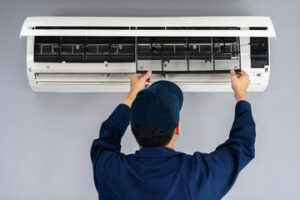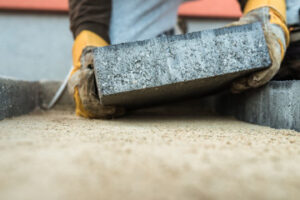Work for an HVAC company requires the ability to respond quickly to calls for repairs and installations. These situations can require technicians to work at unsociable hours, such as nights and weekends.

Air ducts should be professionally cleaned and inspected every two to five years to ensure optimal performance. They also allow for zoning and temperature control, which increase comfort and energy efficiency. Contact Air Conditioning Repair Round Rock TX for professional help.
The cost of HVAC services depends on many factors, including the type and brand of system you choose and its efficiency rating. Energy-efficient systems use less electricity, which translates to lower operating costs. However, these systems usually have a higher initial cost. Another important factor is the size of your building. The amount of heating and cooling you need is measured in tons or British Thermal Units (BTUs). A system that’s too small will struggle to heat and cool your building, while an oversized one will waste energy.
Other factors that influence the cost of an HVAC system include the installation method, ductwork, and insulation. The installation method affects the amount of labor required, which in turn affects the overall cost of the project. For example, a system that requires extensive modifications to the building structure and ductwork will be more costly than a straightforward replacement of an existing system.
Ductwork and insulation are also significant expenses. A new duct system can add up to $10,000 or more, while adding insulation can cost between $10 and $20 per square foot. Other accessories, such as thermostats, indoor air quality upgrades, and dehumidifiers, can also add to the cost of the system.
A good HVAC system will save money in the long run, but the upfront investment can be steep. Choosing a top-rated brand will reduce maintenance costs and extend the lifespan of your equipment. In addition, a high-quality warranty will provide peace of mind.
Regular maintenance will help you keep your heating and cooling bills low by identifying problems like a frayed belt or an overheated motor bearing before they cause extensive damage. Professionals will also ensure that the moving parts of your equipment are properly lubricated, which helps them run smoothly and efficiently.
Climate, home size, and energy rebates in your area shape the cost of a HVAC installation. A system that is sized to meet your needs and is properly installed will save money in the long run. A new system will also increase your home’s value. It’s important to research all your options before making a final decision.
Efficiency
HVAC systems use a significant amount of energy to cool and heat buildings, so their efficiency is an important consideration for everyone. Choosing equipment with high SEER (Seasonal Energy Efficiency Ratio) or HSPF (Heating Seasonal Performance Factor) ratings means that your system uses less energy to provide the same level of cooling or heating as a lower-efficiency model. This can lead to lower energy bills and a more sustainable environment.
In addition to selecting efficient equipment, proper installation and regular maintenance are also vital for HVAC efficiency. A poorly-installed unit may waste energy or cause a breakdown that can increase your operating costs. A professional will install your unit to the correct specifications, ensuring that the optimal level of air comfort is achieved with a minimum of energy consumption.
Regular service of HVAC equipment can also extend its lifespan and help it to maintain its energy efficiency rating. For example, regular lubrication of components ensures that they move easily and do not create excessive friction or wear. This reduces the load on the system and keeps it from working as hard, which can decrease its efficiency. A preventative maintenance visit can also identify issues like frayed belts and worn motor bearings before they break down, saving you money in costly repairs and reducing the stress on your equipment.
The amount of energy consumed by HVAC equipment varies greatly depending on the location, usage, climate conditions and other factors. In the United States, for example, heating and cooling accounts for about 30 percent of total residential and commercial energy consumption. Improving the efficiency of these systems through design, installation, maintenance and use can greatly reduce this figure.
There are many factors that impact HVAC efficiency, including equipment design and the building envelope. For example, a home or business with poor seals will lose a significant amount of heat or air conditioning through gaps and cracks. An energy audit can help determine how to improve this and other aspects of the building that can have a major impact on HVAC efficiency. This can include ductwork, which can be a significant source of wasted energy in some homes.
Maintenance
The term “HVAC” stands for heating, ventilation and air conditioning, so it’s important to keep these systems in good condition for your tenants. Performing regular maintenance tasks such as adjusting thermostat settings for seasonal temperature changes, lubricating moving parts and cleaning around outdoor units and ductwork helps to extend equipment life, save energy costs and provide a comfortable indoor environment.
When you sign up for a maintenance plan, you may be able to get a better rate than what you would pay for emergency repairs. In fact, it’s often said that a dollar spent on preventive maintenance could save up to $10 in repair bills. Having a comprehensive HVAC maintenance plan in place also reduces the likelihood that your unit will experience an unscheduled outage.
The cost of a commercial HVAC system that experiences an unscheduled outage can be costly for a business, especially in the case of food spoilage in restaurants or production shutdowns at manufacturing plants. A HVAC maintenance plan can help reduce the risk of these disruptions and ensure compliance with health and safety regulations.
Regular maintenance also helps improve the performance of your system, which can cut your energy costs. A well-maintained HVAC system is more efficient, which means it uses less electricity to run and produces fewer carbon emissions. This can save your facility money on electricity costs and help to preserve the planet for future generations.
Another benefit of regular maintenance is that it can identify and correct inefficiencies within your system before they become major problems. This can lead to a much lower bill and fewer repairs. It also gives you peace of mind, knowing that your system is running to the best possible standard and meeting all of your needs.
A routine maintenance service will give your contractor a chance to build a relationship with you and become familiar with your system. They will also be able to diagnose problems much more quickly if they know your system and what you expect from it. This builds trust and ensures that any problems are addressed quickly before they escalate and cause more damage.
Installation
Professional installation is an important step in ensuring the proper operation of HVAC systems. It ensures that the system meets its intended performance and comfort benefits. It also minimizes operational costs and maintenance needs. Professionals are trained to handle the complexities involved in installing HVAC systems, including system selection, ductwork design, and proper electrical connections. This helps prevent errors that can lead to poor performance or even damage the unit.
Before the installation process begins, the technicians will assess your space to determine the heating and cooling requirements of your home or commercial facility. They will take into account factors like square footage, insulation quality, and other unique features. They will then recommend systems that are sized appropriately for your space. This prevents the common mistake of installing a system that is too large, which will result in inefficient heating and cooling.
Once the appropriate system is selected, the installation team will prepare the area for the work. This may involve clearing the area where the new unit will be placed and removing any existing equipment. It might also include removing contaminated refrigerant from the old unit, which is then disposed of according to strict environmental standards.
The installation team will then install the ductwork and vents that will distribute heated or cooled air throughout the building. They will also make sure that the ductwork is properly insulated to prevent energy loss. The ductwork will also be designed to minimize leaks and maximize efficiency.
After the installation, the professionals will perform tests to ensure that the new system is operating correctly. They will test the air flow in each room and make adjustments to achieve an optimal balance of airflow. This will prevent hot or cold spots in rooms and ensure that the entire space is comfortable.
During the installation process, it is important to use the right tools for the job. Depending on the type of installation, HVAC professionals will need hand tools such as screwdrivers, wrenches, and pliers to remove and tighten parts and connections. They will also need to have basic tools for ductwork installation, such as a duct cleaning kit, duct tape, and sheet metal screws.
